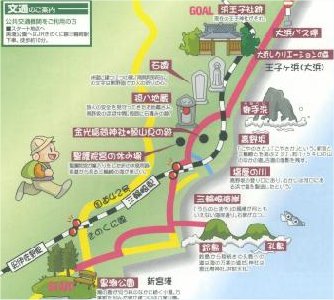Do you know "Koyazaka Slope"? It is not Priest Kukai's Mount
Koya. It is located on the Miwasaki side of Shingu City, Wakayama Prefecture,
near the border with Mie Prefecture.
This slope is a pass on the way from Nachi Grand Shrine to Shingu Hayata
Grand Shrine along Kumano Nada Sea, a luxurious walking spot keeping ancient
remnants such as a thicket forest tangled with ivy and a bamboo forest
with a faint ghostly pattern, and also where you can enjoy the superb view
of the shining Kumano Nada all the way.
It is over the coastal hill from Miwasaki to Hirotsuno in Shingu City,
less than 4 km in distance. The walking time is about one and a half hours.

Click here for a large map.
You can start walking from either side, but this time let's follow the
road from Miwasaki Ward.
After visiting Nachi Grand Shrine, you can take a bus for Shingu, get off
at "Kuroshio Park (Shingu Port)" and walk as shown above, or
you can come to Miwasaki Station by train from Nachi Station and head directly
to Miwasaki Entrance for Koyazaka Slope.
In any case, if you follow the signs and walk east to the foot of the hill, you will cross the railway line and the narrow stream locally called as Shiwa River to the cobblestone entrance.
The information board there says:
|
............
Crossing the seaside plateau of Mitarai from Hirotsuno is this Koyazaka Slope, and there are stone Buddhas, cobblestones, rest areas and observation decks. Although it is a short section of about 1.5 km in length to Miwasaki, it has well preserved the appearance of the past.
In addition, this route is also a scenic spot where you can see the beautiful
coast of Kuroshio waves from the observatory. It can be said that it is
the pass of Kuroshio romance with the belief in the sea god and the tradition
of Priest Jofuku's visit from China here to Kumano associated with this
seacoast. |
|
|
Here are some recommended spots along the way.
|
|
| 1. |
A cobblestone pass awaits you just after entering the slope on the Miwasaki
side. It's only about 50m, but it makes you feel like a step on the old
road. Strangely the chirping of small birds becomes lively all of a sudden. |
|
|
| 2. |
It is a cliff with a high ground observatory made of hinoki (a Japanese
cypress) on top. Directly from the bottom of the cliff, Kumano Nada Sea
spreads far away.
Whether the Kuroshio waves are rough or low is different from time to time,
but the view with several islets nearby and in the distance should be unprecedented.
In particular, when you send your eyes from the waves under the cliff to
the view beyond with Suzushima and Kushima islets in the center, you may
wish to over-describe it as "heavenly arrangement". |
|
|
|
1. Konko Inari Shrine
It is a tiny shrine in the middle of the mountain path. It is an unassuming
appearance, but the quiet atmosphere makes you feel "Don't outstay
your welcome". It is not in such cold air. Please take it easy to
try your courage.
2. Magohachi Guardian Deity
The dimly lit slope alternates wooded and bamboo groves one after another. On the way of the path, you may notice a stone statue called Magohachi Guardian Deity. Don't miss it. It has a red bib hanging on its mossy body. The local people seem to make offerings in passing.
3. Mitarai Tablet Monument
When you approach Hirotsuno Entrance, it is what they call "the best
sightseeing spot" where you can overlook Ojigahama Beach and Kumano
Nada Sea with a panoramic view. This is Mitarai Tablet Monument, a two-stone
pagoda engraved with a six-character name (the letters of 南無阿弥陀仏)
The view of Ojigahama overlooking from here is said to be a famous spot
of everybody's acceptance even on the Kumano Kodo. The waves crashing against
the white sand of Ojigahama truly make smooth and strangely clear sounds.
I spent my childhood in this area, so I don't have much emotion here even
now, but those who see it for the first time seem to be uniformly impressed.
After passing here, it becomes downhill, and soon it is Hirotsuno exit
of Koyazaka Slope. Immediately to the right is the single-track "Kinokuni
Line", and beyond is Ojigahama Beach and Kumano Nada Sea.
If you walk about 2km from here, you can get to the ruins of Hamaoji Shrine.
If you have room for about an hour, follow the signs.
Since you are here in Shingu City, why not tour its famous places and old
ruins as much as time allows? The following are a few of my recommendations.
- Mount Kamikura, Kamikura Shrine - Famous for the Kumano Fire Festival (Lantern Festival).
- Tankaku Castle Ruins - The view of Kumano River from here, it is good.
- Kumano Hayatama Grand Shrine - There is also Haruo Sato Memorial Hall.
(a writer)
- Floating Island Forest (a literally floating island) - Subtropical, Temperate,
and Subarctic trees, plants and flowers coexist.
* 浮島のやまもも熟れて落つるまま (作者不詳)
* ほんに浮島浮いてはいても根なし島とは言わしゃせぬ (野口雨情)
After walking on Koyazaka Slope and visiting famous spots, it is time to
eat.
The dishes of Shingu that I recommend with confidence are:
saury sushi + kitsune (fox) udon + oyako (parent-child) donburi.
Enjoy them in this order according to the condition of your stomach. The
order itself makes a lot of sense. In particular, sanma (Pacific saury)
sushi is the best of all in Shingu.
Koyazaka Slope, 2002
End
Shigeru Koshiba
From Miwasaki of Shingu City, Wakayama Prefecture
Living in Urayasu City, Chiba Prefecture
Written in Japanese, June 9, 2002
Translated into English, August 15, 2022
|